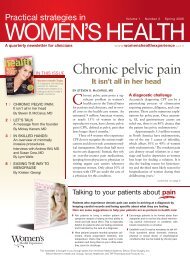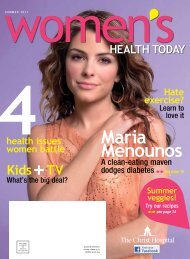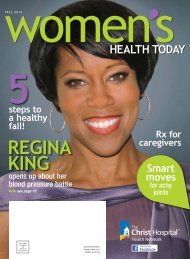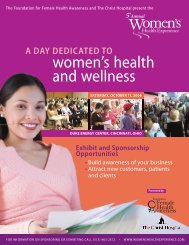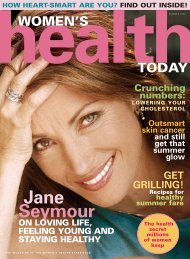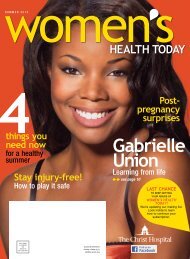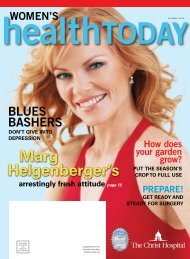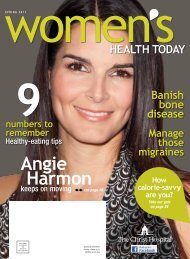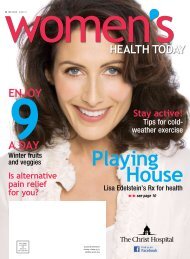Women's Health - The Christ Hospital
Women's Health - The Christ Hospital
Women's Health - The Christ Hospital
Create successful ePaper yourself
Turn your PDF publications into a flip-book with our unique Google optimized e-Paper software.
women’shealthtodays p r i n g 2 0 1 0in this issue . . .2 L E T T E R F R O M T H E F O U N D E RDon’t believe everything you hear!3 Follow these tips for an easier mammogram4 More comfort in chronic illness5 Debunking aging misconceptions6 H E A L T H H E A D L I N E SWhat’s making news in women’s health48 Spring break!Prevent seasonal cleaning health hazards9 S E X & G E N D E R M A T T E R SWomen and strokeKnow the signs!10 Clear as a bell!Kristen Bell lives life with a laugh14 H E A L T H Y B I T E SOrder up a serving of good healthHeart-healthy tips for dining out616 <strong>The</strong> truth about cancer mythsWhat really causes cancer?18 Abnormal test results?Knowing what’s next can ease your worries19 Mother Nature = good medicineHow time outside helps kids stay healthy20 No more kids?Family planning for older women22 H E A L T H Y M O V E SFitness on the fly18 ways to stay active24 H E A L T H S M A R T S<strong>The</strong> ABCs of allergies20www.womenshealthexperience.com
Letter from the founderwomen’shealthtodayt h e m a g a z i n e o ft h e f o u n d a t i o n f o r f e m a l e h e a l t h a w a r e n e s sDon’t believe everything you hear!You’ve probably heard these rumors for years: aspartame causes cancer,deodorants lead to breast disease, and cell phone usage causes braintumors. Researchers and a local oncology expert weigh in on “<strong>The</strong> truthabout cancer myths” (page 16) to help you set your mind at ease. In this same article,you’ll learn about real cancer risks and whether genetic testing is right for you.You can believe the rumors you hear about the dangers of spring cleaning.Before you get on that ladder to wash the windows, turn to “Spring break!” onpage 8 to learn how to stay safe this season. At Women’s <strong>Health</strong> Today, we carenot only about your health but also about that of your loved ones. On page 19,“Mother Nature = good medicine” will help you keep the little ones in your lifehealthy with outdoor activities.<strong>The</strong>se are just a few of the interesting and important health topics you’llfind in this issue of Women’s <strong>Health</strong> Today. We’re here to provide you with usefulhealth information for living your best life! If there’s a subject you’re interested inreading about, please let me know. I’m waiting to hear from you!Sincerely,Mickey M. Karram, MDPRESIDENT AND Co-FounderFoundation for Female <strong>Health</strong> AwarenessDr. Karram and his wife, Mona, are the founders of the Foundation for Female <strong>Health</strong>Awareness, a nonprofit organization dedicated to improving women’s health by supportingunbiased medical research and educating women about their health.F o u n d e r sMickey M. Karram, MD / Mona KarramN a t i o n a l A d v i s o r y B o a r dLinda Brubaker, MD, Professor of Obstetrics and Gynecology,Urogynecology Urology, Loyola University Chicago Stritch Schoolof Medicine; Co-Director, Women’s Pelvic Medicine Center,Loyola University Medical CenterVivien K. Burt, MD, PhD, Associate Professor of Clinical Psychiatry,<strong>The</strong> David Geffen School of Medicine at UCLA; Founder and Director,Women’s Life Center, UCLA Neuropsychiatric Institute and <strong>Hospital</strong>Vivian M. Dickerson, MD, Associate Clinical Professor ofObstetrics and Gynecology, University of California Irvine; Director,Division of General Obstetrics and Gynecology, UCI Medical Center;Director of UCI’s Post Reproductive Women’s Integrative <strong>Health</strong> CenterTommaso Falcone, MD, Professor and Chairman, Departmentof Gynecology and Obstetrics, <strong>The</strong> Cleveland Clinic Foundation;Co-Director, Center for Advanced Research in Human Reproductionand InfertilitySebastian Faro, MD, PhD, Clinical Professor of Obstetrics andGynecology, Women’s <strong>Hospital</strong> of TexasNieca Goldberg, MD, Assistant Professor of Medicine,SUNY <strong>Health</strong> Science Center, Brooklyn, New York;Clinical Assistant Professor of Medicine, New York UniversityThomas Herzog, MD, Professor of Clinical Obstetrics andGynecology, Columbia University College of Physicians and Surgeons;Director, Division of Gynecologic Oncology, Columbia UniversityMedical Center, New YorkBarbara Levy, MD, Medical Director, Women’s <strong>Health</strong> & BreastCenter, St. Francis <strong>Hospital</strong>, Federal Way, Washington; AssistantClinical Professor of Obstetrics & Gynecology, Yale University Schoolof Medicine; Assistant Clinical Professor of Obstetrics and Gynecology,University of Washington School of MedicineWendy l. wright, ARNP, FAANP, Adult/Family NursePractitioner; Adjunct Faculty, Fay W. Whitney School of Nursing,University of WyomingT h e C h r i s t H o s p i t a l S T A F FPresident and CEO Susan CroushoreChief Operating Officer Victor DiPillaChief Nursing Officer Deborah HayesChief Marketing Officer Heather AdkinsChief Medical Officer Berc Gawne, MDEditor Arin Kraemerc u s t o m e r s e r v i c eFor more information about services at <strong>The</strong> <strong>Christ</strong> <strong>Hospital</strong>,please contact Arin Kraemer at arin.kraemer@thechristhospital.com or(513) 585-3945.Women’s <strong>Health</strong> Today is published four times a year by<strong>The</strong> <strong>Christ</strong> <strong>Hospital</strong>, 2139 Auburn Avenue, Cincinnati, OH 45219,in conjunction with the Foundation for Female <strong>Health</strong> Awareness,PO Box 43028, Cincinnati, OH 45243. This is Volume 6, Issue 2.© 2010 by <strong>The</strong> <strong>Christ</strong> <strong>Hospital</strong> and the Foundation forFemale <strong>Health</strong> Awareness. All rights reserved.<strong>The</strong> information contained herein is not a substitute for professionalmedical care or advice. If you have medical concerns, seek theguidance of a healthcare professional.Keep it coming!We’re updating our mailing list and want to ensure our loyal readers continueto receive Women’s <strong>Health</strong> Today. To continue your complimentarysubscription, visit www.<strong>The</strong><strong>Christ</strong><strong>Hospital</strong>.com/women and complete theonline form, or call us at 513-585-1000. We look forward to providing youwith important and timely health information!Women’s <strong>Health</strong> Today magazine is part ofWomen’s <strong>Health</strong> Experience, the flagship program of theFoundation for Female <strong>Health</strong> Awareness. Women’s <strong>Health</strong>recycle-logo_2options_v2.aiExperience is a unique initiative aimed at connecting women withhealthcare experts, as well as their local hospitals, to learn aboutimportant issues that may affect their health. Through Women’s<strong>Health</strong> Experience, Women’s <strong>Health</strong> Today magazine andwww.womenshealthexperience.com, you’ll get objective, timelyinformation. You can also sign up for free e-newsletters containinghealth news Printed With and Soy Ink results Printed of With medical Soy Ink studies.Sign up now at www.womenshealthexperience.com.Please Recycle This PublicationWomen’s <strong>Health</strong> Todayc o v e r : k r i s t e n b e l l© S c ot t M Please c D e r mRecycle ot t / This C o rPublicationb i s O u t l i n ePrinted With Soy InkPlease Recycle This PublicationPrinted With Soy Ink
By Eva L. Lizer, MDFollow thesetips foran easiermammogram• Wear a two-piece outfit to the facility. This way, you’llhave to remove only your top.• Don’t use deodorant, powder or lotion under your arms ornear the breasts that day. <strong>The</strong>se products can show upon the X-ray and may interfere with the radiologist’sability to read the mammogram.Breast cancer that’s detected early has a five-yearsurvival rate of 98 percent. Make your commitmentto early detection today by scheduling a mammogram,if you’re due. WHT© istockphoto.com/evirgenEven though screening mammograms savelives, many women delay getting thembecause of their fear of discomfort and the“nuisance factor.” <strong>The</strong>se tips will make yourmammogram a more pleasant experience:• Know what to expect. While standing at a specialX-ray machine, a technologist will place each ofyour breasts on a platform. <strong>The</strong> breast is graduallypressed against the platform by a clear plastic plate.You may experience some discomfort during thiscompression, but it will only last for a few secondsand is important to obtain the best possible image.• Schedule your mammogram when your breasts will be leasttender. Avoid scheduling your exam for the week beforeyour period, when your breasts are most tender.• Have the necessary information ready. <strong>The</strong> mammographyfacility may ask for:› name and address of your physician› date your last period began or when menopausebegan› dates of any biopsies or other breast treatmentsyou’ve hadIf you’ve had mammograms at other facilities,ask those facilities to release the films to you andbring them with you so the radiologist can check forchanges in your new mammogram.New mammographyguidelines and youLast November, the U.S. Preventive ServicesTask Force (USPSTF) dropped a bombshell:Women, they say, should wait until they’re 50to get their first mammogram, and then onlyrepeat the exam every other year. Other groups,such as the American Cancer Society andAmerican College of Radiology, strongly opposethe new recommendations, saying that mammogramssave the lives of women in their 40s.<strong>The</strong>se groups stand by their advice that annualscreenings should begin at age 40 for women ataverage risk. <strong>The</strong> USPSTF says the new recommendationswill reduce unnecessary follow-uptesting and the anxiety experienced by womendue to false-positive mammograms. Expertsdo agree on one thing: All women should talkto their healthcare providers to determine theirindividual risk for breast cancer and when to gettheir mammograms.Don’t delay!<strong>The</strong> <strong>Christ</strong> <strong>Hospital</strong> offers four convenientmammography locations: Mt. Auburn, Fairfax,Delhi and Mason. To schedule an appointment,call 513-585-2668.Eva L. Lizer, MD, is a radiologist specializing in women’s imaging at <strong>The</strong> <strong>Christ</strong> <strong>Hospital</strong>.www.womenshealthexperience.com
More comfort inchronic illnessPalliative care providesemotional and physical relief››By Rajan Lakhia, DO<strong>The</strong> diagnosis of a chronic, progressive illnessoften leads to many struggles for patientsand their families. <strong>The</strong> complexity of treatmentoptions, coping with pain and questionsabout how to prevent your disease from takingover your life can be overwhelming. Some patientsand their families are fortunate to have discovered aspecialty of medicine known as palliative care that canhelp them not only better navigate treatment but alsorelieve their physical and emotional discomfort.With rapidly advancing technology and medications,care options can be confusing, particularlywhen an illness is complicated. A palliative care consultationcan help strengthen and empower patientsto make healthcare decisions with added confidenceand live their lives as fully as possible.Improving quality of lifeA common misconception about palliative care isthat it’s only for patients who need end-of-life care.In fact, palliative care can also be helpful for patientswho are expected to fully recover from an acute illnessor suffering from a chronic illness. Regardlessof the circumstances, the goal of palliative care is toaggressively treat symptoms causing distress to maximizecomfort and improve quality of life.Physicians and nurses specializing in palliativecare work alongside the physicians treating and<strong>The</strong> care you need is here!To learn more about palliative care, visitwww.<strong>The</strong><strong>Christ</strong><strong>Hospital</strong>.com or call 513-585-4157.managing a patient’s illness. Relieving physicalsymptoms is one of the key aspects of any palliativecare program and may involve pain managementthrough medication or modifying physicalactivity, recommendations on how to improvesleep or picking foods that fill nutritional needs.What’s especially unique about palliativecare is its focus on the emotional and spiritualsymptoms that often accompany illness, not justfor the patient but for his or her family, too.Chaplains, ministers and social workers can beactively involved as treatment partners to helpeveryone work through the challenges anextended illness can bring. <strong>The</strong>ir guidance canlead to resolutions about spiritual issues or mayhelp family caregivers become better prepared tocare for their loved one. WHT© istockphoto.com/NeustockimagesRajan Lakhia, DO, is the medical director of palliative care at <strong>The</strong> <strong>Christ</strong> <strong>Hospital</strong>.Women’s <strong>Health</strong> Today
Debunking agingmisconceptions ›› By Elven MentionMost of us wish old age would nevercatch up with us. Often we fear endingup irritable, forgetful or frail in ouradvanced age. Well, the good news isthat none of us is predestined to become the stereotypical“old-timer.” Researchers now know that manylong-held beliefs about aging are actually myths.<strong>The</strong> idea that we’re fated to experience an inevitabledownward health spiral is a major misconception.Our medical fate is decided not only by ourgenes but also by diet, lifestyle and stress. Our lateryears can be a time of mental growth, spiritual happinessand even physical renewal. Here are more“old-timer” misconceptions:?“Old age means being sick.” In fact, 63 percent of allfolks ages 65 to 69 and 56 percent of people ages70 to 74 are disability free. Staying healthy in old agecomes from having both physical and mental strength.?“Learning stops at 65.” Although the pace oflearning in later years is slower, the ability tolearn doesn’t necessarily fade with age. In fact, manyseniors become computer savvy, learn a language ortake up a sport.?“It’s too late to get healthy.” Better nutrition,weight control and exercise are proven waysto reduce your risk of cancer, heart disease, hypertension,osteoporosis, diabetes and maybe evenAlzheimer’s disease.?“I don’t have the genetics for long life.” Researcherssay only about 25 percent to 30 percent ofaging is gene-related. <strong>The</strong> rest is decided by how wechoose to live.?“I’m too old for romance.” Intimacy, it turns out,continues at least into our 80s, limited only byour condition and attitude. And the need for holdingand touching persists our entire lives.<strong>The</strong>re’s never been a better time to be an olderAmerican. By maintaining your physical, mental andemotional health, your later years could becomeyour best ones yet! WHTReeling in the yearsSenior Care Preferred Plus is a <strong>Christ</strong> <strong>Hospital</strong>health and wellness program for those ages 50 andolder. <strong>The</strong> program offers travel opportunities, socialactivities, healthcare discounts and wellness eventsfor just $20 a year. Learn more about how thisprogram can help you stay healthy and active—call513-585-4001 or visit www.<strong>The</strong><strong>Christ</strong><strong>Hospital</strong>.com.Elven Mention is manager of <strong>The</strong> <strong>Christ</strong> <strong>Hospital</strong>’s Senior Care Preferred Plus program.www.womenshealthexperience.com
what’smaking newsin women’shealthhealthheadDon’t let fitnessfade with agenew study suggests that fitness can fade fast afterA age 45. In the study, published in Archives ofInternal Medicine, using a treadmill test, researcherslooked at the cardiorespiratory fitness of 3,429 womenand 16,889 men ages 20 to 96. <strong>The</strong>y found that cardio-respiratory fitness decreased after age 45, especiallyfor adults with a higher body mass index and thosewho smoked and didn’t exercise very much. Beingout of shape as you age increases your risk of severaldiseases and makes you more likely to have to dependon others. If you haven’t exercised in a while, ask yourhealthcare provider about safe activities you can try toincrease your physical fitness at any age.Sugar = highblood pressure?You’re likely aware that eating lots ofsugary foods can increase your waistline.It may, however, present anotherhealth threat: high blood pressure. In astudy presented at the American Societyof Nephrology’s 42nd Annual Meeting,researchers examined 4,528 adults ages 18and older with no history of high blood pressure.<strong>The</strong>y investigated how much of thesugar fructose these adults consumed fromfoods such as juice, soda, baked goods andcandy. Researchers found that people whoate or drank more than 73 grams of fructosea day (about two-and-a-half sodas) had amuch higher risk of developing high bloodpressure. To keep your blood pressure in ahealthy range, cut back on soft drinks, bakedgoods and other foods and beverages thatcontain added sugars. Try naturally sweetenedfruit instead.Women’s <strong>Health</strong> Today
lines© istockphoto.com/drfelice/lenm/spxChromePage 6 © 2010 JupiterimagesDetectingovariancancerOptimists, rejoice!For women, a “glass half-full” outlook on life may lead to positive effects on the heart.Researchers at the University of Pittsburgh studied more than 97,000 postmenopausalwomen ages 50 to 79 who, at the start of the study, were free of cancer and cardiovasculardisease. Optimistic women, compared to their pessimistic counterparts, hada 9 percent lower risk of developing heart disease and a 14 percent lower risk of dyingfrom any cause after more than eight years. Optimism was measured by asking people<strong>The</strong>re’s a newweapon in thebattle against ovariancancer: <strong>The</strong> Food and Drug Administration hasapproved a test that can help detect ovarian cancerwithin a pelvic mass. For women ages 18 and olderwho are already surgical candidates because ofsuch a mass, OVA1 tests blood for levels of proteinsthat change due to ovarian cancer. It then outputsa score that shows whether the pelvic mass is likelyto be benign or malignant. Women with a positiveOVA1 finding but negative results from other cancertesting may benefit from a gynecologic oncologist’sopinion about surgical options. Referral to anoncologist may also be indicated for women whohave a negative OVA1 result if they have other findingsthat may suggest the presence of cancer. WhileOVA1 can’t screen for ovarian cancer or definitivelydiagnose it, healthcare providers can use these testresults as a referral guide.whether they agreed with statements such as, “Inunclear times, I usually expect the best,” and “Ifsomething can go wrong for me, it will.” Levels ofcynical hostility were measured with statementssuch as, “It’s safer to trust nobody,” and “I haveoften had to take orders from someone who didnot know as much as I did.” Women with a highlevel of cynical hostility, compared to those with alow level, were 16 percent more likely to die duringeight years of study. African-American womenwho had a positive outlook had a 33 percent lowerrisk of death after eight years of study, while optimisticCaucasian women had a 13 percent lowerrisk. Researchers also found that optimists wereless likely to have diabetes, high blood pressureand high cholesterol; smoke cigarettes; be sedentary;or have a high body mass index. <strong>The</strong> linkbetween optimism and heart disease remained,even after taking into account all of these factors.www.womenshealthexperience.com
Spring break!‹‹ Prevent seasonal cleaning health hazards ››Weeding, painting and scrubbing the ovenall seem like pretty safe tasks. But everyyear, thousands of people get hurt duringwell-meaning spring-cleaning sprees.Ladder injuries alone send thousands of people each yearto the ER. Here’s how to avoid becoming a statistic:• Wise up to the ways of the ladder:› › Before you climb, make sure the ladder is sturdyand that the rungs are dry and in good shape.› › Place the ladder on an even, firm surface.› › Put the ladder’s locks or braces in place.› › Don’t climb too high. On a stepladder, stopat the second rung from the top; on an extensionladder, don’t go above the fourth rung from the top.<strong>The</strong> Home Safety Council recommends moving thebase of the ladder out 1 foot for every 4 feet you climb.› › Don’t lean too far to one side—the ladder couldtip. A good rule of thumb: Don’t let your belly-button stray beyond the sides of the ladder.› › Don’t sit on top of a stepladder. <strong>The</strong> shelfisn’t meant to carry your weight.• Get rid of piles. Clear clutter from stairs,landings and floors to avoid falls.• Lift and carry the right way:› › Stand with your feet shoulderwidthapart.› › Keep your back straight andbend at the knees while tightening your stomachmuscles.› › Lift with your legs.› › Enlist a helper if something is too heavy orcumbersome.› › When climbing stairs, only carry loads you can seeover and that allow you to keep one hand free for railings.• Skip the chemical cocktails. Never mix cleaning products,such as bleach and ammonia; doing so can producedangerous fumes. Read directions carefully to makesure you’re using the product correctly, or try “greener”cleaning products made from all-natural ingredientsthat are less caustic. Or mix your own safe solvent:Use a little baking soda and water to clean the ovenor combine lemon juice or vinegar with water for anontoxic glass cleaner.❝Ladderinjuries alonesend thousands ofpeople each yearto the ER. ❞• Get the right gear. Wear a mask and gloves to protectyour nose and hands from harsh cleaners.• Don’t overdo it in the garden. Repetitive motions can causemuscle aches, so alternate between weeding,digging, planting and pruning.• Take a break. Be sure to replenish yourbody’s fluids and prevent dehydration,especially in warm weather. If you feeldizzy or short of breath or have chestpain, call for emergency medical assistanceright away. WHT© istockphoto.com/iofoto/izusek/aCathyKaplan/AmorphisWomen’s <strong>Health</strong> Today
sex & Gender matters<strong>The</strong> latest findings on women-specific healthfrom the Society for Women’s <strong>Health</strong> ResearchBy Sarah Keitt, MPHWomen and stroke }Know the signs!© istockphoto.com/ranplettStroke is the third leading cause of death forwomen in the United States. Accordingto the American Heart Association, about55,000 more women than men will have astroke each year. A stroke occurs when blood flow tothe brain is disrupted either by a blockage or by bleedingin the brain. When either happens, brain cellsbegin to die and brain damage occurs. Not usuallyfatal but often disabling, a stroke can have a long-termimpact on a woman’s productivity, her ability to carefor her family and her own independence.Prevention and recognition are keyWomen can take several steps to lower their riskof having a stroke. <strong>The</strong> National Stroke Associationrecommends exercising, watching your weight andblood pressure and not smoking to help lower yourrisk. If you have a family history of stroke or sufferfrom migraines with auras, talk with your physicianabout the use of oral contraceptives and menopausalhormone therapy.It’s not possible to prevent all strokes, butrecognizing the early signs of a stroke can minimizedisability. <strong>The</strong> most common symptoms include:• sudden numbness or weakness of the face, arm orleg—especially on one side of the body• sudden confusion, trouble speaking or understanding• sudden trouble seeing in one or both eyes• sudden trouble walking, dizziness, loss of balance orcoordination• sudden severe headache with no known cause.Women often suffer different and less familiarsymptoms of stroke such as sudden face and limbpain, hiccups, nausea, general weakness, chest pain,shortness of breath and heart palpitations. WHTAct FAST!If you or someone you know is experiencingthese signs of a stroke, it’s crucial to act F.A.S.T.:• Face: Ask the person to smile. Does one sideof the face droop?• Arms: Ask the person to raise both arms.Does one arm drift downward?• Speech: Ask the person to repeat asimple sentence. Are the words slurred?Can he or she repeat the sentence correctly?• Time: If the person shows any of the abovesymptoms, time is important. Call 911 at once.Learn more!<strong>The</strong> Society for Women’s <strong>Health</strong> Research is anonprofit research, education and advocacyorganization that works to improve women’shealth through sex-specific research, educationand advocacy. To find this articleand more of the latest news andresearch on women’s health, visitwww.womenshealthresearch.org.Sarah Keitt, MPH, is program manager for the Society for Women’s <strong>Health</strong> Research in Washington, D.C.www.womenshealthexperience.com
❝ <strong>The</strong> key tostaying activeis to make movementan ordinarypart of your day.❞If you already exercise regularly …›› Reprogram your listening habits. Instead of music,11 listen to a book on tape while walking.›› Get better. Take a private lesson or hire a12 personal trainer for some customized pointers.›› Get competitive. Take your sport to the next13 level. Sign up and train for a race or walkathon(many are for good causes). Join a local team; checkyour YMCA, YWCA or health club for leads.›› Mix it up. If you’ve always biked alone, check14 out a cycling club. If you regularly work out witha friend, try a solo session once a week.›› Cross train. Work different muscles and feel15 the power of your body in a new way. If you’rea runner, try racquetball. If you lift weights, giveballroom dancing a whirl.›› Plan an exercise16 vacation. Consider skitrips, bike excursions, hikesand city walking tours.›› Push harder.17 Exercising at least30 minutes or more onmost days? Up your intensityor go longer. Mix in someyoga for flexibility or free weightsfor strength.›› Reward yourself. When you hit an exercise18 milestone, treat yourself to a new outfit, aromaticbath salts or a massage. WHTwww.womenshealthexperience.com 23
<strong>Health</strong> smarts<strong>The</strong> ABCs of allergiesMore than 35 million Americans suffer from seasonalallergies (seasonal allergic rhinitis), or “hayfever.” If you’re one of these people, you probably dealwith sneezing; a stuffy and runny nose; and itchinessof your throat, eyes, ears, nose and the roof of yourmouth. <strong>The</strong> most common culprits of seasonal allergies:pollen and mold spores in the air. How much doyou know about this pesky problem? Test your knowledgeby answering true or false to these statementsand checking your answers.True or False?{1} Pollination only occurs during the springtime.{2} People with pet allergies are allergic toanimals’ hair.{3} Allergy symptoms are often less severe onrainy, cloudy or windless days.{4} An allergic reaction is your body sending outa false alarm.{5} You can move to another state to escapeyour allergies.Answers:{1} False. <strong>The</strong> usual pollen season lasts from Februaryor March through October—but in warmer places, itcan be year-round. Seasonal allergic rhinitis is oftencaused by tree pollen in the early spring, grasses duringthe late spring and early summer and weeds duringthe late summer and fall.{2} False. Contrary to popular belief, people are notallergic to an animal’s hair but to allergens found inthe dander (dead skin flakes), saliva or urine of ananimal with fur. All dogs and cats carry these kindsof proteins, so no breed is naturally allergy-free. Toavoid exposure to pet dander, keep pets out of roomsyou spend the most time in. Vacuum carpets often orswitch to hardwood, linoleum or tile floors.{3} True. Pollen doesn’t move around during theseconditions and travels more with hot, dry and windyweather, which can increase allergy symptoms.{4} True. An allergy is your body overreacting to aharmless substance. Your immune system views anallergen, such as pollen or mold, as an invader andstarts to defend your body. White blood cells of theimmune system produce IgE antibodies that cause therelease of chemicals such as histamine. <strong>The</strong>se chemicalscause you to have symptoms such as a runnynose, itching and sneezing.{5} False. Many pollens and molds are common tomost plant zones in the United States—so unfortunatelyyou can’t move to escape your allergies. Also, becauseyour allergy problem is genetic, you will probably reactto new allergens in any new environment. WHTTest yourhealthknowledgeonlineTake more health quizzes andassessments online atwww.womenshealthexperience.com.Plus, find out what other womenare saying by participatingin our online polls!24Women’s <strong>Health</strong> Today
Stay informedStay connectedStay healthyPresented by thewith www.womenshealthexperience.comWomen’s <strong>Health</strong> Experience offers you healthnews and information just for women!Sign up for a free monthly e-newsletter that delivers thelatest health news, trends and tips to your inbox.Test your health smarts on fitness, nutrition, diseaseprevention and more with online quizzes.Take our online health assessments to learn yourrisk for common diseases and conditions.Learn what other women are thinking byparticipating in our online health polls.Find out what the Women’s <strong>Health</strong> Experiencecan do for you!It’s all here—and it’s all for you atwww.womenshealthexperience.comTM
Bringing a baby into the world is one of the most beautiful things we canexperience. At <strong>The</strong> <strong>Christ</strong> <strong>Hospital</strong> Birthing Center, we’re making it even moreso with state-of-the-art technology to care for mother and baby in the comfortof our all-private birthing suites, and more: Feng shui & hydrotherapy birthing suites Staff with average of 15 years’ experience Interactive TV system with on-demand movies Expanded Level II Special Care Nursery Internet access Room-service style nutrition servicesTake a virtual tour of our Birthing Center at <strong>The</strong><strong>Christ</strong><strong>Hospital</strong>.com/women.For more information on our childbirth services,classes or to schedule a tour, please call us at513.585.1000Caring Above All ṢM2139 Auburn Avenue | Cincinnati, OH 45219




